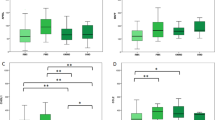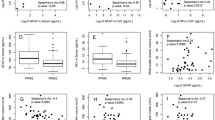Abstract
The aim of this study was to assess whether mean serum levels of inflammatory markers when measured serially correlate with disease progression or putative MRI markers of axonal loss in a cohort of well-characterised multiple sclerosis (MS) patients. Serial serum levels of soluble vascular cell adhesion molecule-1 (sVCAM-1), soluble intercellular adhesion molecule-1 (sICAM-1), nitric oxide metabolites nitrate and nitrite (NOx), C-reactive protein (CRP), neopterin and tumour necrosis factor alpha (TNF-α) were measured in 29 MS patients, 13 with a relapsing remitting (RR) and 16 with a secondary progressive (SP) course, who were participating in a phase II clinical trial of anti-CD4 therapy. Short-term whole blood stimulated TNF-α production was also measured. Patients were studied 12 times over an 18-month period. MRI variables included the number and volume of Gd-enhancing lesions and the change in T2-hyperintense, T1-hypointense lesions and cerebral volume between the baseline and exit studies. Disease progression required a sustained change in the EDSS. There was no correlation between mean levels of inflammatory markers over the study period and disease progression or changes in any of the MRI measures. However, mean sICAM-1 levels from the first 6 months of the study were higher in patients who progressed during the study than in those that did not (443 (SD439) vs. 235 (SD162) ng/mL, p=0.05). Mean levels of NOx were significantly higher in patients with RR MS than in patients with SP disease (59.1μmol/L (SD 12.8) vs. 48.7μmol/L (SD 11.9), p=0.02). Patients with either a single relapse or no relapse had significantly higher NOx levels than to patients with multiple relapses during the 18 month follow-up (59.0μmol/L (SD 12.3) vs. 47.9μmol/L (SD 12.0), p=0.02). The mean levels of the other inflammatory markers did not correlate with disease course or relapse-rate. Serum levels of many inflammatory markers do not correlate with short-term disease progression. Some of the data suggest that the effects of inflammation on disease progression are delayed. In addition raised levels of serum nitric oxide metabolites are associated with a lower number of clinical relapses and a non-progressive disease course. These findings, although preliminary, pose interesting questions on the role of nitric oxide in the pathogenesis of MS. Inducible NO production in the early stages of the disease may be beneficial.
Similar content being viewed by others
Author information
Authors and Affiliations
Additional information
Received: 14 August 2000, Received in revised form: 8 December 2000, Accepted: 30 December 2000
Rights and permissions
About this article
Cite this article
Giovannoni, G., Miller, D., Losseff, N. et al. Serum inflammatory markers and clinical/MRI markers of disease progression in multiple sclerosis. J Neurol 248, 487–495 (2001). https://doi.org/10.1007/s004150170158
Issue Date:
DOI: https://doi.org/10.1007/s004150170158




